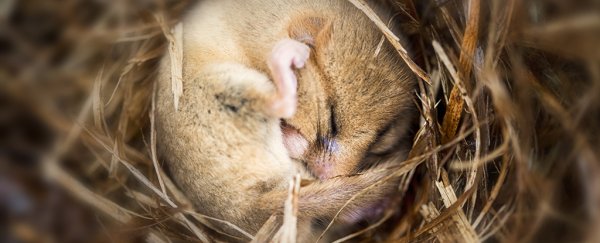Two separate studies have identified the elusive brain 'switches' that send mice into a hibernation-like state of torpor. This discovery could lead us closer to figuring out how to put other animals - even humans - in the same suspended state, which can be incredibly useful for an organism to do.
When an animal goes into torpor, the physiological activity in their body goes way down; this is especially characterised by a significantly reduced body temperature and metabolic rate. That lower body temperature conserves energy - useful when food is not as abundant, such as in winter.
Scientists already knew that certain parts of the brain are heavily involved in the thermoregulation animals need to achieve hibernation, but these latest studies have greatly advanced our understanding of the neurons that play a central role in this process.
The biological ability to reduce energy use and slow down metabolism on demand is potentially highly useful for all kinds of health applications. If we could ever safely trigger this process in humans, a hibernation-like state could help a person's body to survive something that would otherwise cause serious damage or death.
And, of course, space travel is the obvious example – imagine finding a way to put humans into suspended animation for long treks to the far reaches of the galaxy. It sure sounds like a space opera for now, but understanding what an animal's brain does to induce torpor is a fantastic starting point to see if there's any chance we can ever achieve it in humans.
When mice are deprived of food for 24 hours or so, they naturally go into torpor to conserve energy - a feature researchers can use to their advantage.
In the first study, scientists were investigating a group of neurons in the hypothalamus they call quiescence-inducing neurons, or Q neurons. These particular nerve cells express a neurotransmitter called QRFP (pyroglutamylated RF-amide peptide).
The team discovered that when Q neurons are stimulated, they trigger something like hibernation in mice for over 48 hours, reducing body temperature and metabolism – that's significantly longer than natural torpor cycles last for mice, but the animals all recovered afterwards with no signs of ill effects.
The team also identified a wider network of support neurons in the mouse brain that seem to contribute to the process of dropping their body temperature, and then successfully demonstrated how Q neurons could be manipulated with neurotransmitters and laser light in both mice and rats.
In a separate, second study, a different team of researchers were able to genetically tag and identify the neurons that were activated in the hypothalamus as mice entered torpor, and to reactivate them - once more triggering torpor - after the mice had been fed and their body temperature warmed up again.
Having spotted these neurons, the scientists linked the largest subset of them to the expression of the gene for PACAP (pituitary adenylate cyclase-activating polypeptide), a protein known to have a role as a neurotransmitter. Stimulating these neurons was shown to trigger torpor, while blocking them disrupted the normal torpor cycle of the mice.
There seems to be some chemical overlap between the groups of neurons both studies identified in terms of PACAP and QRFP expression, and "the results of the two studies, taking very different approaches, reinforce one another," write neurologists Clifford B. Saper and Natalia L.S. Machado in an accompanying News & views article on the research.
While it's fun to speculate about hibernating humans, it's good to remember these findings are nowhere near being applied to people yet; however, scientists have often wondered if animals who don't naturally hibernate have some hidden ability to do so, that just needs activating.
Besides being useful for trips to far-off spots in the Universe, being able to put people into a state of torpor could limit the damage caused by serious injuries – but for now the research is only just getting started.
"Trying to pin down which neurons are involved with initiating torpor and hibernation… is certainly something that biologists have been interested in for several years now," biologist Steven Swoap from Williams College, who was not involved in the research, told The Scientist.
"Both of [the teams] come at it from a different angle and almost end up in the same place, so they complement each other in that way, which is pretty nice."
The two studies have been published in Nature here and here.
